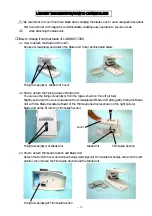
4
SAFETY INSTRUCTIONS
7KH%HVW/LIW6HULHVRIIXOOERG\SDWLHQWOLIWVUHÀHFWLQQRYDWLYHVWDWH
RIWKHDUWGHVLJQWRLQFUHDVHXVHUPRELOLW\$%HVW/LIWZLOOSURYLGH
\HDUVRIVHUYLFHLILWLVSURSHUO\PDLQWDLQHGDVDQ\HOHFWULFDQGRU
mechanical equipment requires. Please pay careful attention to the
following important information regarding the care, maintenance, and
operation of the patient lift. Carefully read these instructions before
DVVHPEOLQJWKHOLIWHURUDWWHPSWLQJWROLIWDXVHUZLWKWKHGHYLFH
PLEASE NOTE THE FOLLOWING:
Special care must be taken with users/patients who cannot themselves provide
assistance while being lifted. (i.e. patients who are comatose, spastic, agitated, or
otherwise severely handicapped.)
The patient lift should be used solely for transferring a user/patient from one
utility (beds, chairs, toilets, etc.) to another. The patient lift should not be used for
transporting or moving any patient from one location to another location.
During lifting or lowering, whenever possible, always keep the base of the lift in the
widest position.
The base of the lift should be closed before moving the lift.
Do not roll casters over any object while the user/patient is in the sling.
Do not lock casters during lifting.
While being lifted in a sling, always keep the user/patient centered over the base and
facing the caregiver operating the lifter.
Never leave the user/patient unattended during lifting.
The BestLift allows a person to be lifted and transferred safely, with minimum physical
effort provided by the caregiver. Before attempting to lift anyone, please practice
operating the lift. Also prior to actual lifting, explain the lifting procedure to the user/
patient.
Summary of Contents for BestLift 400 Series
Page 2: ......
Page 26: ...NOTES 26...





































